
Offshore Optimism
Operators remain long-term bullish on the Gulf of Mexico, citing new technologies expected to open exploration to even deeper waters.
Article by Eldon Ball
Photography by Peter Piazza
The years 2012 and 2013 were marked by significant growth in the number of shallow-water and deepwater wells drilled. Some industry forecasters see that growth continuing, albeit at a somewhat slower pace, through 2015 and beyond, particularly in the deep.
Oil production is expected to rise from about 1.3 million barrels per day (MMbbl/d) currently to 1.6 MMbbl/d by year-end 2015, with some 11 projects coming onstream, according to the most recent projections from the U.S. Energy Information Administration (EIA).
However, there are uncertainties: the price of oil, now trading below $80/bbl; Saudi Arabia’s refusal to give up market share to support prices; and an economic slowdown in Europe, China and India that could dampen oil demand.
So, what lies ahead for the GoM? Often called “the gift that keeps on giving” and “the cat with nine lives,” is it now due for a slowdown in activity? Has the cat used up its ninth life?

“The Gulf is not dead,” declared Bob Fryklund, vice president, global exploration and production analysis, IHS. “I call it the ‘forgotten Gulf,’ because everybody’s got shale fever, and they forget that the Gulf of Mexico is actually doing pretty well. There are still some pretty interesting places where people picked up stuff in the last lease sale.”
Fryklund thinks the industry still considers the Gulf one of the choicest offshore basins in the world. And indeed, companies from private-equity-backed startups to international majors continue to seek out its opportunities and cash flow.
Stephen Pastor, for one, asset president, conventional, BHP Billiton, said his company sees plenty of opportunity in the GoM. “We’ve got demonstrated top performance in deepwater, and lots of capacity to do more. We’re looking forward to having the opportunity to do more through success with our exploration program, through asset acquisitions, or any partnering opportunities that might arise.”

BHP is moving ahead aggressively with major projects in the Gulf. “We’re very active at Atlantis; we have a two-rig program there. We’ve got two rigs drilling at Mad Dog—one that’s on the production spar drilling infill wells, trying to maximize use of the facility’s capacity, and one that’s starting to drill new wells for the Mad Dog Phase 2 project that we’re trying to move to FID [final investment decision] sometime over the next few years,” Pastor said.
“We have lots of opportunities around our discovered and producing fields that have cost advantages and economic return advantages associated with the existing infrastructure that we’ve already invested in.”
Stephen Pastor, BHP Billiton
David Reid, deepwater appraisal manager, Shell Upstream Americas, also likes the GoM and is especially enthusiastic about new opportunities soon to open on its Mexican side.

“I think it’s going to produce tremendous opportunity,” he said. “It will take time. We need to get the seismic data. We need to get the mobile rigs. The terms and conditions need to be right—conducive to investment. But under the right conditions, I can see a whole frontier of play concepts that will emerge in Mexico.”
Research firm Douglas-Westwood forecasts offshore drilling and production activity on a quarterly basis for the Gulf. In the near-term, the U.K. firm sees production being choppy, according to Mike Haney, director, but from 2019 on, it is quite positive, with a view that crude production will exceed 1.5 MMbbl/d. At that point, deepwater projects such as Shell’s Appomattox and Vito fields in Mississippi Canyon should come online, in addition to a number of other projects currently under development.

“There are a number of major projects in development at the moment, and we’re going to see new barrels coming on line in the next couple of years,” Haney said. “Generally speaking, the Gulf has suffered somewhat from rising supply-chain costs in recent years. This is one of the factors contributing to project delays we’ve seen in the region [such as at BP’s Mad Dog and ExxonMobil’s Hadrian North fields]. But in our view, there will be an upturn in the coming years—this tends to work in cycles.”
Haney said Douglas-Westwood sees strong overall investment in deepwater regions worldwide, with the estimated spend to hit $260 billion between 2014 and 2018, more than double that in the prior five-year period.
Deepwater Appraisal Manager
Shell Upstream Americas
Tom Williams, president and managing director of LEID LLC, is also optimistic about the future of the Gulf of Mexico, “so long as we can continue to get leases and have a fair regulatory system in place, and have a healthy industry. And as long as the government doesn’t decide to increase taxes and increase royalties or make it uneconomical or do stupid things, then we’ll have a healthy Gulf of Mexico for a long, long time. There’s a tremendous amount to be done and there’s a tremendous amount of resources still there.”

The challenge, Williams said, is whether an operator can take a 100 MMbbl field and make it economic.
“…if it’s a 100-million-barrel field, how can I increase that productivity from 15% recovery to potentially 20% or 25% recovery, like they have done in the North Sea? That’s the magic bullet for the Gulf of Mexico. Once they can figure out how to increase productivity and make what are considered marginal reservoirs economic, we’ll be drilling there for our great-, great-grandkids.”
Growth mode
Jason Nye, senior vice president, U.S. offshore for Statoil, agrees. The Norwegian firm, a world leader in offshore technology, is partnering with Chevron, Anadarko, Shell and Hess in the Gulf.
“We’re definitely in growth mode in the Gulf of Mexico, and I think the future’s extremely bright,” he said. “This is a big part of our portfolio going forward, and it’s going to be a significant contributor to the bottom line. Through enhanced recovery, through technology, through the high-quality people that we have here and the good teamwork, we believe that the future’s extremely bright in the Gulf of Mexico, and we’re here for the long term, and we’re looking forward to that first operative discovery so we can go off to the races with the development.
“Having said that, we enjoy working with the partners that we have,” Nye added. “These are all world-class operators, and we really appreciate the collaborative and cooperative approach they take, the way we share information and push these projects. It adds great value for these projects.”
Operators all say they are dealing with the big issue of rising costs for projects in deepwater thanks to greater well complexity, deeper water depths, and more federal regulatory requirements in the aftermath of the BP Macondo tragedy.
Indeed, IHS’ Fryklund cited new regulations, as well as insurance costs. “And we believe there are more directives coming on insurance and liability. In some ways, that is keeping some players out on an international basis, because they do have some fears. They want to make sure that they work with operators that have the operational skills, and also the financial skill, to withstand any kind of incidents.”
The good news, he said, is that “we’re not increasing costs as fast as we used to. So, it’s leveled off, but it continues to grow at a 2% to 3% range, which when compounded, makes it pretty steep. The other side of the cost equation is, though, that most of that now is labor and project management.”


Enabling technology
Operators, suppliers and service companies agree that the key to success in deepwater plays is the availability of enabling technology. In that regard, the industry has been prolific in producing new equipment, engineering and procedures.
Neil Duffin, president of ExxonMobil Development Co., said the progression of new technology has taken the industry through many generations of development, leading to the current level of advanced engineering. He expects the evolution to continue, particularly in the subsea realm with new deepwater frontiers.
“We’re starting to see industry breakthroughs in subsea compression and separation that may replace some of the surface infrastructure currently used,” Duffin said. “Those breakthroughs are going to be part of the advanced technologies that will reduce the costs sufficiently to be able to work safely in these very challenging areas.

Neil Duffin: ExxonMobil Development
“Some of the work is in the pilot stages in different areas around the world,” he said. “For example, our Julia development in the deepwater Gulf of Mexico is using a high-integrity deep-pressure management system and subsea pumping to enable that development to go ahead by tying back to existing infrastructure.
“The Julia Field is one of the deepest projects to be developed in this way and has six subsea oil wells and a water depth at 7,100 feet, tied back to the Chevron-operated Jack/St. Malo development, another deepwater development we’re a part of. We’re going to drill the Julia wells using one of the highest capability rigs in existence because of the rig loads. They’ll be developed subsea, and the viscous Julia oil will be produced along with the Jack/St. Malo crude.
“As with Julia, it’s important for the industry to work together on these complex deepwater developments to utilize as much of the capacity that’s available out there so it can be managed within reasonable costs,” Duffin said. “It’s not just a question of being able to develop them; it’s being able to develop them safely and make them economic.”
“The technologies that are available for deepwater are fantastic,” Reid said. “There’s amazing technology all across the spectrum. We now have more production system choices than we’ve ever seen in deepwater. That in itself has taken us into deeper waters and it’s allowed us to move forward into more frontier areas. That’s what you see with all these play types opening in deeper water.”
Seismic imaging has advanced significantly as well, with wide-azimuth, 3-D and 4-D technology, for instance. “The ability to get the geological concepts in context with the processers has helped us understand the subsurface better,” Reid noted.
“As we move forward, I think we’re going to see a need for more robust completion technology. As we drill deeper, we’ll get into hotter temperatures and higher pressures. The drawdowns that we’re going to see, the depths and pressures, are just going to be a lot larger. We’re going to get into things such as ceramic screens and all this really great technology that you’re going to see deployed into oil and gas.”
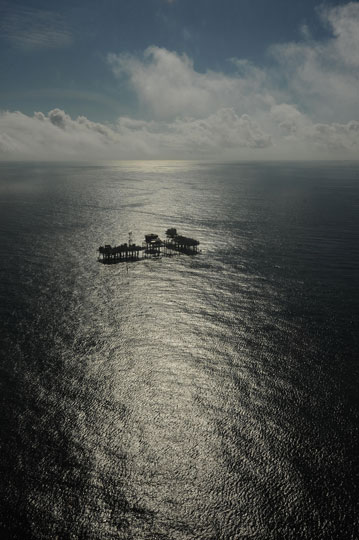
Eugene Island 120 Central Facility off the south-central coast of Louisiana.
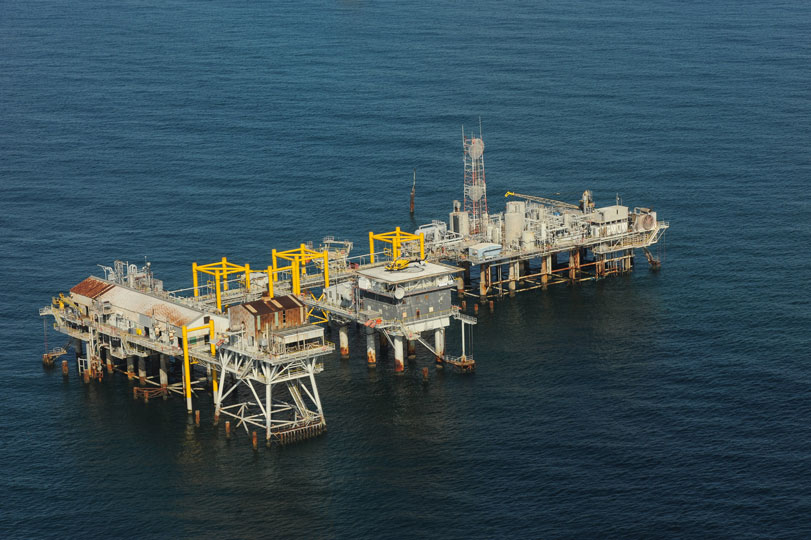
Eugene Island 120 Central Facility off the south-central coast of Louisiana.

Fieldwood Energy Rig Eugene Island 125 A-5 ST1. The rig is drilling in 40 feet of water in holes that were opened in the 1950s at a depth of 15,000+ feet. The name of the jackup rig is the Cecil Provine.
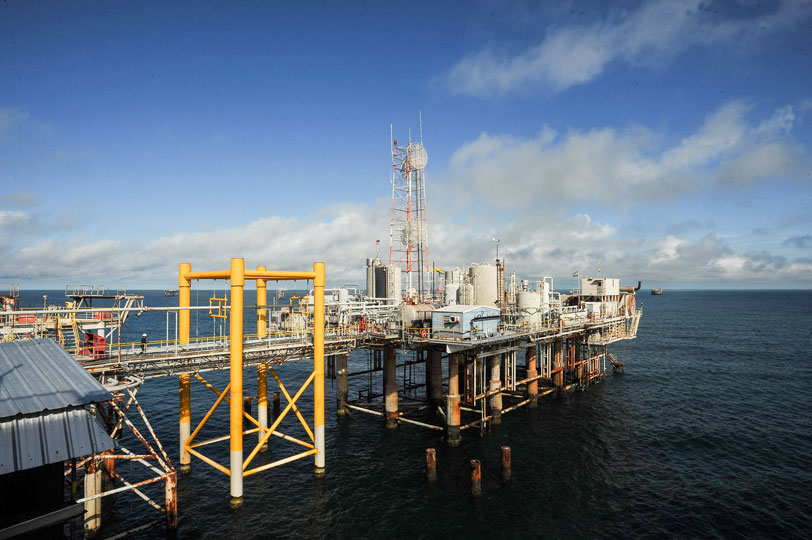
Eugene Island 120 Central Facility off the south-central coast of Louisiana.

Eugene Island 120 Central Facility off the south-central coast of Louisiana.

Bruce Broussard looks over sections of tubing on the Fieldwood Energy Central Facility on Eugene Island block 120 off the south central Louisiana coast.

Eugene Island 120 Central Facility off the south-central coast of Louisiana.
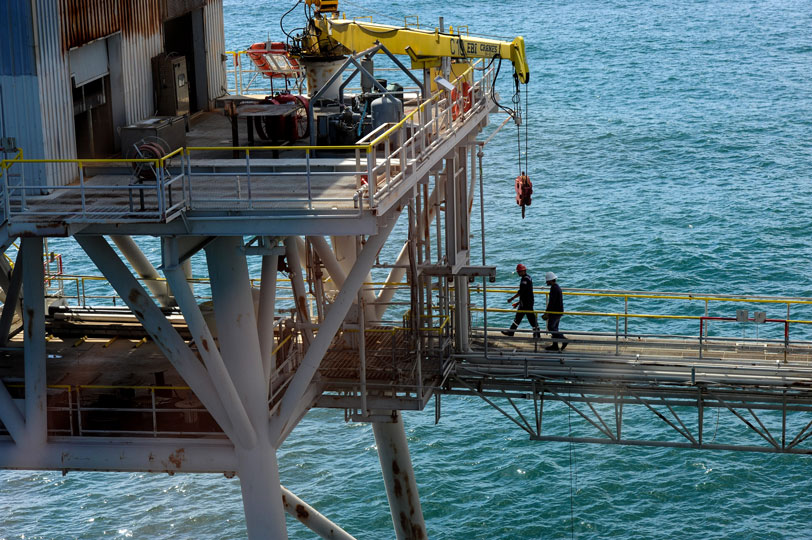
Eugene Island 120 Central Facility off the south-central coast of Louisiana.

Fieldwood Energy jackup rig at Eugene Island block 125 A-5 ST1.

Fieldwood Energy jackup rig at Eugene Island block 125 A-5 ST1.

Fieldwood Energy jackup rig at Eugene Island block 125 A-5 ST1.

Fieldwood Energy jackup rig at Eugene Island block 125 A-5 ST1.

Fieldwood Energy jackup rig at Eugene Island block 125 A-5 ST1.

Fieldwood Energy jackup rig at Eugene Island block 125 A-5 ST1.

Fieldwood Energy jackup rig at Eugene Island block 125 A-5 ST1.
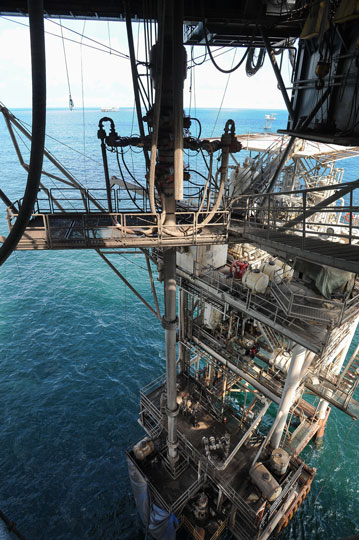
Eugene Island 120 Central Facility off the south-central coast of Louisiana.
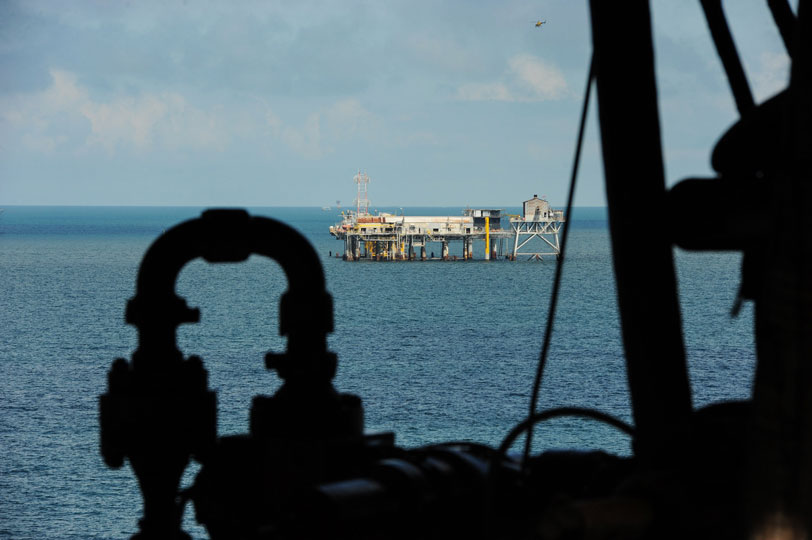
Eugene Island 120 Central Facility off the south-central coast of Louisiana.

Fieldwood Energy jackup rig at Eugene Island block 125 A-5 ST1.

Fieldwood Energy jackup rig at Eugene Island block 125 A-5 ST1.

Fieldwood Energy jackup rig at Eugene Island block 125 A-5 ST1.
Boosting well recoveries
As an example of technology in action, Nye points to the success Statoil has had in increasing production from existing fields in the North Sea.
“We’ve gotten to over 50% of recovery now in Norway, and we’re aiming for 60%,” he said. “We think that a lot of the technology that’s employed there is applicable here, and we’re still in the relative maturity of secondary and tertiary recovery here. We have a long way to go.
“We see in fields like Tahiti in the Gulf—a water-injection project—very positive results, and it was definitely worth it because of the enhanced recovery. We’re looking at gas injection in various places too. At our Paleogene fields, we’re about to start producing from injecting Jack and St. Malo this year. We’re a partner in that, and that’s our first venture into the emerging Paleogene Wilcox play.
“That’s been a fantastically run project on time and on cost, and we’re set to come on first production later this year. Those are massive fields, but because it’s Paleogene and carries some uncertainty, we sanction these fields with fairly low recovery factors. You know, low double-digits, but we think that the potential there over the long term to increase recovery is tremendous.”
Statoil and its partners are using subsea pumps, he said, “but we think the future is with things like ESPs [electric submersible pumps], or various other technologies where we will ultimately bring the recovery from these Paleogene fields maybe up to 20%.”
Statoil is also a partner with ExxonMobil on the nearby Julia Field, set to come onstream in 2016.
“That’s a tieback to Jack/St. Malo,” Nye said. “That field itself is as big as Jack and St. Malo combined. It’s got about six billion [bbl] in place—one of the biggest fields in the Gulf of Mexico—but the challenges in the Paleogene are the rocks, and it’s also the fact that it’s dead oil. There’s not a lot of gas, so it doesn’t want to flow naturally.
“We seek several things with technology—multi-phased subsea pumps, ESPs, gas injection, multilateral wells; and through this technology, revenue increases to our company, significantly. So we sanctioned that Julia project. As I say, we were looking at 6% or 7% recovery, and we’re able to clear that hurdle because it’s just so large.
“If we can apply technology and double or triple that recovery, you’re talking a billion barrels of additional oil. That’s worth looking into and worth the investment, and these fields will be producing for 30 to 40 years. They’re just coming on now, but these are massive, and they’ll produce a long time. They’ll have long tails, so we’ll have a lot of time to test and qualify and apply new technology.
“I should say, this isn’t really new technology,” Nye added. “It’s existing technology, but in a new environment. We’re taking the existing practices that we used, for instance on the Norwegian continental shelf, bringing them here in deeper waters, deeper pressures, higher temperature reservoirs, so it’s about modifying existing technologies to apply in the Gulf of Mexico. As we see it, we think it’s a potential for ancillary recovery in both Miocene, but especially the Paleogene fields, as it’s quite large.”
Challenges for drillers
For a drilling company such as Transocean, weather and wellbore geometry join loop currents, higher temperatures and higher pressures as challenges that it faces when operating in the deepwater GoM. However, enabling technology makes the difference between possible and impossible. According to Transocean CEO Steven Newman, technology that doesn’t yet exist will be the key to moving into even greater water depths.
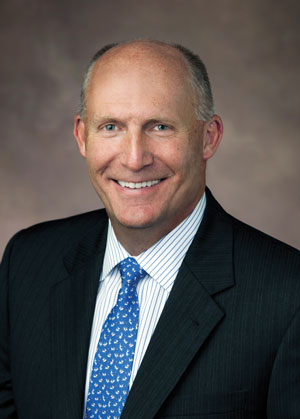
“We hear a lot of commentary from our customers about the ability to drill 20,000-psi reservoirs,” Newman said. “And maybe you can drill from a pure exploration perspective—drill and assess what’s there—but you can’t develop it yet until the industry can deliver a true 20,000 [psi] BOP. And you have to be really careful with your casing design and your mud program and your formation evaluation, just to keep everything under control,” he said.
Transocean has transitioned its deepwater fleet in the Gulf to dynamically positioned (DP) vessels, to provide hurricane avoidance capability, Newman said.
The DP capability also enables the rig to be taken off location and moved quickly to another one, reducing customers’ wait time.
“What the operator is really focused on is how quickly you can get on location and start drilling the well,” Newman said. “If you’re trying to moor up a rig in 5,000, 6,000 or 7,000 feet of water, you could spend the better part of a week laying out the mooring system before the rig can go to work. Whereas if you’re a DP rig, you’d pull up on location and drop four seabed transponders and do the grid and can be ready to go to work in six or 12 hours. From an operator’s perspective, the efficiency associated with getting on and off of location at the beginning and end of a well, using a dynamically positioned rig, has a benefit.”
Deepwater rig design
Another major challenge for deepwater drilling is the size of the rig needed for greater hook loads as operators go ever deeper. The industry is already building rigs capable of operating in 12,000 feet of water, but in order to carry the hook load, deck load and the subsea load, the rig’s got to be bigger.
“The rigs we’re building today, capable of operating in 12,000 feet of water, are mammoth machines,” Newman said. “For the drilling contractor, it presents an interesting balancing act, because to drill in that kind of water depth, all things being equal, you’d like a bigger vessel. But a bigger vessel attracts a higher environmental load, so you think about the wind and the waves and the current operating against that bigger vessel. All of that requires a bigger power plant and bigger thrusters to counteract all that force.
“What we’d like to be able to do is build a bigger structure on a smaller footprint, and minimize the environmental loading on the rig. Building a smaller footprint requires a smaller, more efficient power plant and a better set of fit-for-purpose thrusters.”
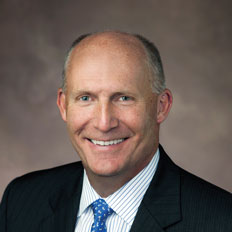
Steven Newman: Transocean
Through any innovation, drillers are trying to meet their customers’ needs.
“They pay for the diesel fuel, so if we can provide them with something that—all else equal—burns less diesel, that’s a cost benefit to them. So the five rigs that are under construction for Transocean are being built with hybrid power plants—it’s the first time that’s ever been done in the industry.”
Hybrid power plants combine power generation and storage to offset power usage by using gravitational force to generate power when going in the hole with pipe.
“The biggest variable power consumer on a drilling rig is the hoisting operation,” Newman said. “When you’re hoisting pipe you consume a lot of power, and when you’re lowering, you can generate a lot of power current because of gravity. As we lower the load into the wellbore, we’re generating power. We dump that into a big industrial-size bank of batteries—capacitors. Then, when we need the load because we’re hoisting, we draw from that set of capacitors.”
Transocean will be able to operate the power plant at a lower level and use the system of capacitors to account for the peaks and the balance, providing customers with a more cost-efficient drilling program.
“Plus, we’re able to say, ‘Look, recognizing the industry that we’re in, these are more environmentally friendly than any other drilling rig on the planet,’” Newman said.
Shallow-water plays
Although the deepwater play in the Gulf gets most of the headlines, a number of privately financed exploration and production (E&P) operators have taken large positions in shelf assets, hoping to get another 5% to 10% or more from those properties.
“Shelf activity is going to be affected by gas prices, of course, which have moved up into the $4/MMBtu neighborhood,” said Douglas-Westwood’s Haney. “If the independents are able to improve project economics and remain versatile, they can make the shelf profitable, even if the cash-flow economics do not suit the majors.”
One of the largest players on the shelf is Fieldwood Energy, a Houston-based portfolio company of Riverstone Holdings LLC. Fieldwood is led by CEO Matt McCarroll and other former senior executives of Dynamic Offshore Resources. The venture represents the second partnership between Riverstone and the Fieldwood management team, who previously partnered to build Dynamic Offshore Resources LLC into one of the largest operators on the Gulf of Mexico Shelf.
“Fieldwood started in early 2013, and frankly, it didn’t start as necessarily a Gulf of Mexico idea,” said McCarroll. “It was the core group; with me was the former management team of Dynamic Offshore Resources, which was a Gulf of Mexico operator that we sold in 2012. Shortly thereafter, we regrouped and decided to start another venture with our partners at Riverstone.
“Initially we did not have a defined business plan, so we looked at a number of conventional, undercapitalized situations, but none were compelling enough for us to execute a transaction,” McCarroll said. “Then, in May 2013, we got a call from Apache saying they were interested in selling their entire Gulf of Mexico operation. We dropped everything else we were doing, knowing that the prospect of buying a successful business of this scale and scope is a once-in-a-career opportunity.
“The exploration game on the shelf is difficult,” McCarroll said. “The easy stuff’s been found. We happen to think there’s still very attractive exploration targets in the Gulf of Mexico—shallow water and deepwater—and we’re pursuing a number of those, primarily through new seismic acquisition and processing.”

Acquire and develop is really buying something at or below what it’s worth today and making it worth more, McCarroll said.
“We’ve got a large inventory of exploration prospects, most of which we either have recently shot seismic over or are in the process of shooting and reprocessing seismic over, predominantly targeting subsalt and near-salt targets around salt domes in the Gulf,” McCarroll said. “That’s kind of our strategy, and we’re using reverse time migration seismic processing to be able to better image these areas; so far, the results have been encouraging.”
More to come
Tracy Krohn, who founded W&T Offshore in 1983 and still serves as the company’s CEO, believes in the GoM, especially thanks to improved seismic imaging that can be used to further develop older fields that he has acquired.
Speaking at Hart Energy’s Offshore Executive Conference in Houston in October, he said: “I hear this all the time about the Gulf of Mexico, that ‘That’s all there is’ and ‘We’ve found everything’ and ‘The basin’s dying’ and ‘The Gulf is dead.’ Well, I say, ‘The Gulf is dead, long live the Gulf.’”
CEO
W&T Offshore
Krohn’s outlook is underpinned by the fact that industry has found better ways to image Gulf prospects, especially below salt.
“The next iteration is going to be wide-azimuth surveys. With it we’re able to analyze, with mass computation abilities, all of the ray paths in a 360-degree pattern. That makes it a little bit more exciting.
“We had an acquisition at Mahogany Field, the first commercially productive subsalt discovery on the planet. I looked at the seismic used by the original operator when they first drilled that field, and said, ‘Why did they drill this field?’ I couldn’t see a thing. You could certainly see the salt, but you couldn’t see the structure below. They drilled the well and it was a great discovery.
“We now operate Mahogany and we put a rig there three years ago and intended to drill one or two wells. Here we are, three years later, and we’re still drilling wells. We’re on No. 10 and about to be on well No. 11 shortly. It’s amazing that we’ve been able to find this additional oil, but it’s all because of the imaging. The second generation was remarkably better than the first, and the third generation was even better still.”
Recently, W&T found some reserves, deeper, that were better than the original field pay, as far as permeability and porosity characteristics are concerned. “Now we’re going to get the wide-azimuth data next year and we’re hoping it will have a similar effect.”
Opening Up Mexico's Side
The latest, and for the moment most speculative, opportunity in the GoM is the opening of Mexico’s side, particularly the deepwater portion often referred to as Perdido South.
After all, the geology of the prolific deepwater on the U.S. side of the Gulf certainly does not end at the border with Mexican waters.
“It is certainly an area worth keeping an eye on,” Statoil’s Jason Nye said.
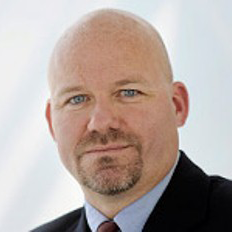
Jason Nye: Statoil
“We have high hopes for Mexico in the medium and long term, especially as regards their ability to make these reforms ‘stick.’ However, one of the country’s national holidays marks the day the oil industry was nationalized in 1938—so it may be easy for politicians to demagogue this issue. Outside observers need to be patient and hope for the best, both for Mexico and for the world’s energy supply.”
Transocean’s Steven Newman also is eyeing this new opportunity, citing the prospectivity of the geology.
“So you take a map of the Gulf of Mexico and take the arbitrary international boundary, right. That doesn’t dictate geology. We’ve drilled for customers who have developments that are as near to that international boundary as you can get without creating an international incident.
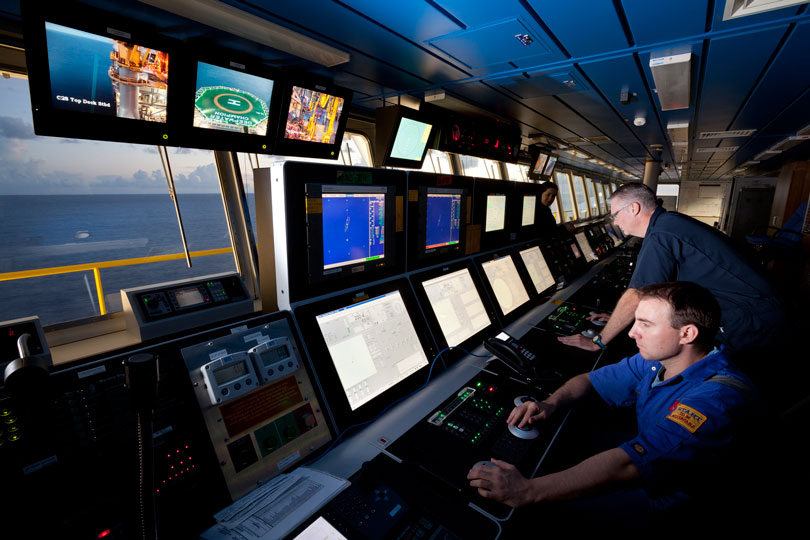
Transocean senior dynamic positioning operators maintain the Deepwater Champion over a drilling location from the ultradeepwater, dual-activity drillship’s bridge control room during operations in the Gulf.

Discoverer Invictus, a dynamically positioned drillship, is working in the Gulf of Mexico for BHP Billiton on a long-term contract. It is rated to drill in water depths to 12,000 ft and can drill to 40,000 ft.

The Discoverer Clear Leader is at work for Chevron on a long-term contract in the Gulf of Mexico. Like Invictus, it can drill to 40,000 ft.
“And the geology exists on the other side as well. If you overlay the Mexican side of the Gulf of Mexico on the U.S. side, it’s every bit as much acreage.”
Newman expects the Mexican side to open up within the next five years, although he said forecasting is difficult. “I think it will be relatively slow to begin with, but once you build up a foundation and a base load of activity, then it could really take off.”
Nye echoes Newman’s optimism. “I have to say that we are pleasantly surprised by the pace of change there and very happy with the way things are developing. There are still some details to work out, but in terms of the Round Zero and the Round One announcement that we had in August, and the changing laws, we were very pleasantly surprised. As for the deals and the details, we’ll have to still look at the fiscal terms, at how they’ll actually award these blocks.”
Nye thinks the timing of new leases looks promising.
“We’ve been waiting a long time, and this feels real,” he said. “I think that their plan is toward blocks as early as next year. “
Recommended Reading
Talos Energy Expands Leadership Team After $1.29B QuarterNorth Deal
2024-04-25 - Talos Energy President and CEO Tim Duncan said the company has expanded its leadership team as the company integrates its QuarterNorth Energy acquisition.
Energy Transfer Ups Quarterly Cash Distribution
2024-04-25 - Energy Transfer will increase its dividend by about 3%.
ProPetro Ups Share Repurchases by $100MM
2024-04-25 - ProPetro Holding Corp. is increasing its share repurchase program to a total of $200 million of common shares.
Baker Hughes Hikes Quarterly Dividend
2024-04-25 - Baker Hughes Co. increased its quarterly dividend by 11% year-over-year.
Weatherford M&A Efforts Focused on Integration, Not Scale
2024-04-25 - Services company Weatherford International executives are focused on making deals that, regardless of size or scale, can be integrated into the business, President and CEO Girish Saligram said.






